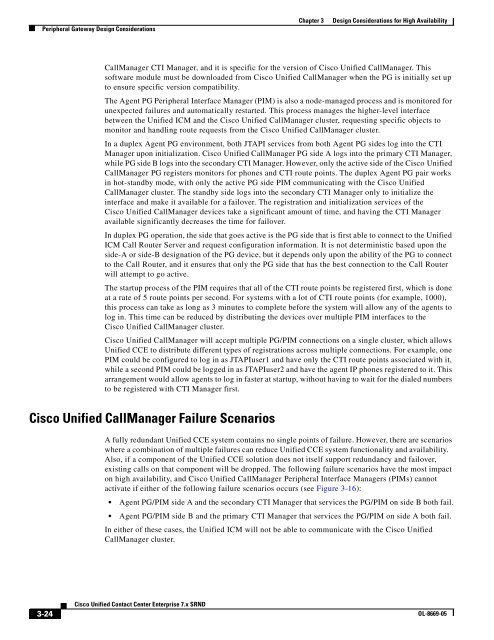Cisco Unified Contact Center Enterprise Solution Reference ...
Cisco Unified Contact Center Enterprise Solution Reference ...
Cisco Unified Contact Center Enterprise Solution Reference ...
Create successful ePaper yourself
Turn your PDF publications into a flip-book with our unique Google optimized e-Paper software.
Peripheral Gateway Design Considerations<br />
3-24<br />
<strong>Cisco</strong> <strong>Unified</strong> <strong>Contact</strong> <strong>Center</strong> <strong>Enterprise</strong> 7.x SRND<br />
Chapter 3 Design Considerations for High Availability<br />
CallManager CTI Manager, and it is specific for the version of <strong>Cisco</strong> <strong>Unified</strong> CallManager. This<br />
software module must be downloaded from <strong>Cisco</strong> <strong>Unified</strong> CallManager when the PG is initially set up<br />
to ensure specific version compatibility.<br />
The Agent PG Peripheral Interface Manager (PIM) is also a node-managed process and is monitored for<br />
unexpected failures and automatically restarted. This process manages the higher-level interface<br />
between the <strong>Unified</strong> ICM and the <strong>Cisco</strong> <strong>Unified</strong> CallManager cluster, requesting specific objects to<br />
monitor and handling route requests from the <strong>Cisco</strong> <strong>Unified</strong> CallManager cluster.<br />
In a duplex Agent PG environment, both JTAPI services from both Agent PG sides log into the CTI<br />
Manager upon initialization. <strong>Cisco</strong> <strong>Unified</strong> CallManager PG side A logs into the primary CTI Manager,<br />
while PG side B logs into the secondary CTI Manager. However, only the active side of the <strong>Cisco</strong> <strong>Unified</strong><br />
CallManager PG registers monitors for phones and CTI route points. The duplex Agent PG pair works<br />
in hot-standby mode, with only the active PG side PIM communicating with the <strong>Cisco</strong> <strong>Unified</strong><br />
CallManager cluster. The standby side logs into the secondary CTI Manager only to initialize the<br />
interface and make it available for a failover. The registration and initialization services of the<br />
<strong>Cisco</strong> <strong>Unified</strong> CallManager devices take a significant amount of time, and having the CTI Manager<br />
available significantly decreases the time for failover.<br />
In duplex PG operation, the side that goes active is the PG side that is first able to connect to the <strong>Unified</strong><br />
ICM Call Router Server and request configuration information. It is not deterministic based upon the<br />
side-A or side-B designation of the PG device, but it depends only upon the ability of the PG to connect<br />
to the Call Router, and it ensures that only the PG side that has the best connection to the Call Router<br />
will attempt to go active.<br />
The startup process of the PIM requires that all of the CTI route points be registered first, which is done<br />
at a rate of 5 route points per second. For systems with a lot of CTI route points (for example, 1000),<br />
this process can take as long as 3 minutes to complete before the system will allow any of the agents to<br />
log in. This time can be reduced by distributing the devices over multiple PIM interfaces to the<br />
<strong>Cisco</strong> <strong>Unified</strong> CallManager cluster.<br />
<strong>Cisco</strong> <strong>Unified</strong> CallManager will accept multiple PG/PIM connections on a single cluster, which allows<br />
<strong>Unified</strong> CCE to distribute different types of registrations across multiple connections. For example, one<br />
PIM could be configured to log in as JTAPIuser1 and have only the CTI route points associated with it,<br />
while a second PIM could be logged in as JTAPIuser2 and have the agent IP phones registered to it. This<br />
arrangement would allow agents to log in faster at startup, without having to wait for the dialed numbers<br />
to be registered with CTI Manager first.<br />
<strong>Cisco</strong> <strong>Unified</strong> CallManager Failure Scenarios<br />
A fully redundant <strong>Unified</strong> CCE system contains no single points of failure. However, there are scenarios<br />
where a combination of multiple failures can reduce <strong>Unified</strong> CCE system functionality and availability.<br />
Also, if a component of the <strong>Unified</strong> CCE solution does not itself support redundancy and failover,<br />
existing calls on that component will be dropped. The following failure scenarios have the most impact<br />
on high availability, and <strong>Cisco</strong> <strong>Unified</strong> CallManager Peripheral Interface Managers (PIMs) cannot<br />
activate if either of the following failure scenarios occurs (see Figure 3-16):<br />
Agent PG/PIM side A and the secondary CTI Manager that services the PG/PIM on side B both fail.<br />
Agent PG/PIM side B and the primary CTI Manager that services the PG/PIM on side A both fail.<br />
In either of these cases, the <strong>Unified</strong> ICM will not be able to communicate with the <strong>Cisco</strong> <strong>Unified</strong><br />
CallManager cluster.<br />
OL-8669-05
















